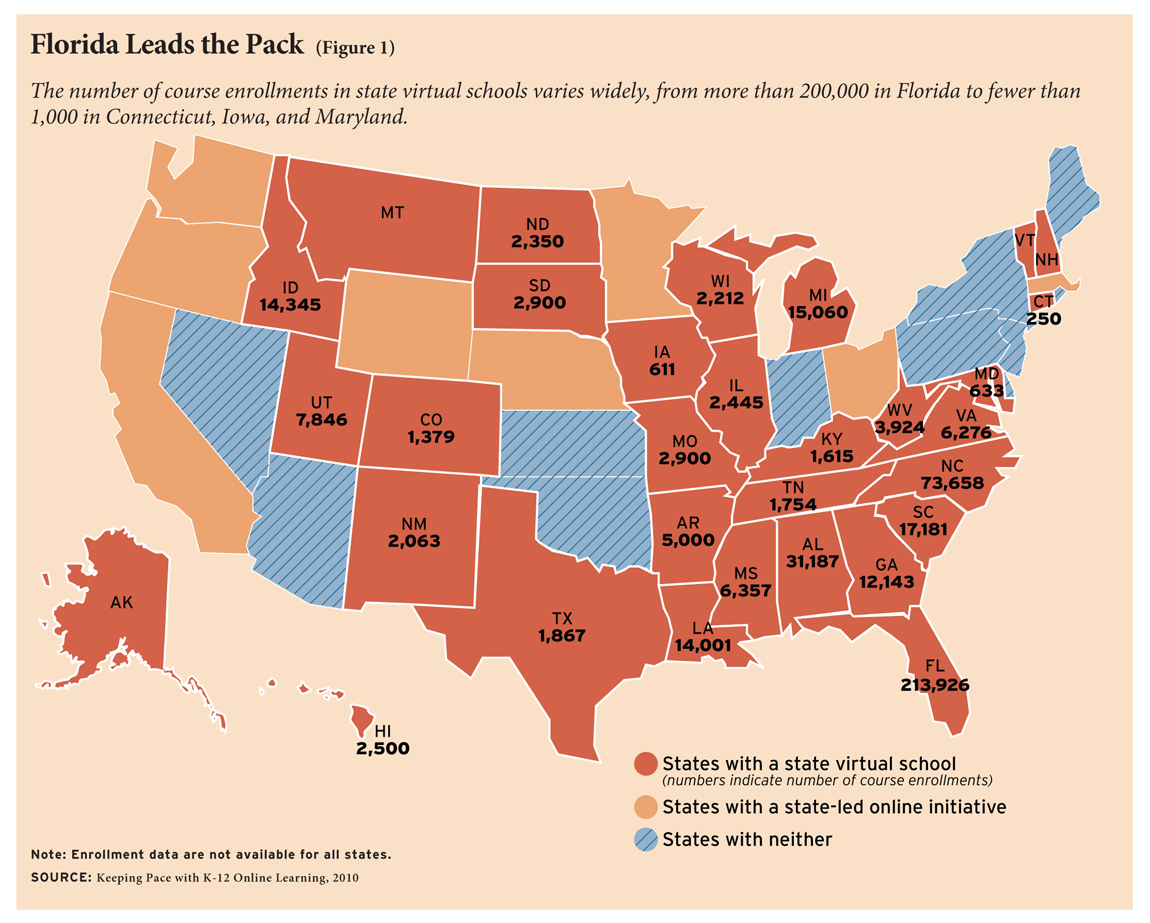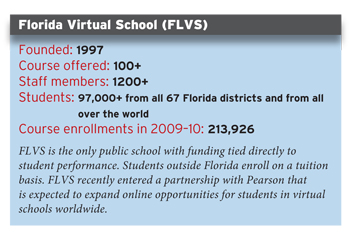 Advocates for virtual education say that it has the power to transform an archaic K–12 system of schooling. Instead of blackboards, schoolhouses, and a six-hour school day, interactive technology will personalize learning to meet each student’s needs, ensure all students have access to quality teaching, extend learning opportunities to all hours of the day and all days of the week, and innovate and improve over time. Indeed, virtual education has the potential not only to help solve many of the most pressing issues in K–12 education, but to do so in a cost-effective manner. More than 1 million public-education students now take online courses, and as more districts and states initiate and expand online offerings, the numbers continue to grow. But to date, there’s little research or publicly available data on the outcomes from K–12 online learning. And even when data are publicly available, as is the case with virtual charter schools, analysts and education officials have paid scant attention to—and have few tools for analyzing—performance. Until policymakers, educators, and advocates pay as much attention to quality as they do to expansion, virtual education will not be ready for a lead role in education reform.
Advocates for virtual education say that it has the power to transform an archaic K–12 system of schooling. Instead of blackboards, schoolhouses, and a six-hour school day, interactive technology will personalize learning to meet each student’s needs, ensure all students have access to quality teaching, extend learning opportunities to all hours of the day and all days of the week, and innovate and improve over time. Indeed, virtual education has the potential not only to help solve many of the most pressing issues in K–12 education, but to do so in a cost-effective manner. More than 1 million public-education students now take online courses, and as more districts and states initiate and expand online offerings, the numbers continue to grow. But to date, there’s little research or publicly available data on the outcomes from K–12 online learning. And even when data are publicly available, as is the case with virtual charter schools, analysts and education officials have paid scant attention to—and have few tools for analyzing—performance. Until policymakers, educators, and advocates pay as much attention to quality as they do to expansion, virtual education will not be ready for a lead role in education reform.
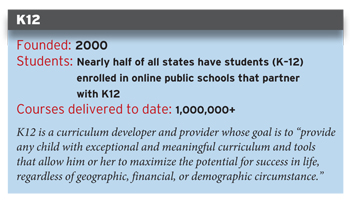 Virtual education is in a period of rapid growth, as school districts, for-profit providers, and nonprofit start-ups all move into the online learning world. (See sidebars for just a few examples.) But without rigorous oversight, a thousand flowers blooming will also yield a lot of weeds. Real accountability, including the means to identify and end ineffective practices and programs, must be constantly balanced with the time required to refine new, immature technologies and approaches to learning. Both virtual education advocates and education policymakers should learn from nearly two decades of experience with charter schooling, another reform movement predicated on innovation and change within public education. After nearly 20 years of practice, the charter school movement provides important lessons on how to ensure that improved student outcomes remain the top priority.
Virtual education is in a period of rapid growth, as school districts, for-profit providers, and nonprofit start-ups all move into the online learning world. (See sidebars for just a few examples.) But without rigorous oversight, a thousand flowers blooming will also yield a lot of weeds. Real accountability, including the means to identify and end ineffective practices and programs, must be constantly balanced with the time required to refine new, immature technologies and approaches to learning. Both virtual education advocates and education policymakers should learn from nearly two decades of experience with charter schooling, another reform movement predicated on innovation and change within public education. After nearly 20 years of practice, the charter school movement provides important lessons on how to ensure that improved student outcomes remain the top priority.
Focus on Outcomes
At present, virtual education lacks a firm understanding of what high performance looks like. The situation is not unlike that faced by the charter school movement just a few years ago. In 2005, after a decade of rapid growth in the charter school sector, the National Alliance for Public Charter Schools (NAPCS) was formed to increase the availability of high-quality charter schools. NAPCS soon published “Renewing the Compact,” a statement by its Task Force on Charter School Quality and Accountability. “Renewing the Compact” came on the heels of an August 17, 2004, lead story in the New York Times, which highlighted findings from a simplistic, and controversial, study of charter school achievement sponsored by the American Federation of Teachers, “Charter School Achievement on the 2003 National Assessment of Educational Progress (NAEP).” According to the Times, in “virtually every instance, the charter students did worse than their counterparts in regular public schools.” The NAPCS task force did not mince words about the need for a sharper focus on quality within the charter school movement. The report challenged the charter community to “fully ‘own’ the issue of how well its schools perform” and also challenged charter advocates “to embrace rigorous measures of quality and accountability for our own schools’ success.”
But the wide range of education options within charter schooling makes “owning” quality difficult, and the variety is even greater for virtual education. Virtual public education can be delivered by all types of providers, including charter schools, for-profit companies, universities, state entities, and school districts. Types of online schools and programs range from state-run programs like Florida Virtual School, where each year 100,000 students take one or two courses online as a supplement to traditional schools, to “blended” models, which allow schools to combine online and classroom-based instruction. The most controversial virtual schools are so-called “cyber” charter schools—fully online public schools that students “attend” on a full-time basis. Funded with public dollars but independently run, many of these cyber schools are managed by private, for-profit companies such as K12 and Connections Academy. John Watson, author of the annual “Keeping Pace” report on the status of K–12 virtual learning, notes that virtual education is “several times more complex than charter schooling.”
Such diversity brings challenges. While the International Association for K-12 Online Learning (iNACOL) has published program quality standards, virtual education lacks a commonly accepted set of quality outcome measures. Quality can’t be defined by the design of a school or by inputs alone; instead, it must focus primarily on outcomes. Traditional measures, such as attendance and instructional contact hours, do not fit the virtual model. And while federal and state accountability systems, which focus on school-level accountability, provide data on and oversight of the performance of full-time cyber schools, there’s little data and few mechanisms for evaluating supplemental and blended programs, in which students take only a portion of their schooling online. Moreover, it’s the supplemental and blended courses, increasingly offered by school districts, where growth is likely to be fastest.
Still, complexity can’t be an excuse for inaction. Unless providers rise to this task, outside groups, whether supporters or opponents, will define success and the lack of it for them. Once again, the charter experience is worth noting. Less than two years after publishing “Renewing the Compact,” the NAPCS, in partnership with the National Association of Charter School Authorizers, which was established in 2004 to push for more professionalism and higher standards among authorizers across the country, convened a working panel on charter school quality with the goal of establishing a “common set of basic quality expectations and performance measures” to assess charter school success. Without these measures, the panel noted, “it is no wonder that judgments about the performance of charter schools are so frequently ill-informed.” The result of the working panel was “A Framework for Academic Quality,” which provides a list of indicators, such as student achievement levels and growth measures, to which schools should be held accountable, metrics that can be used to assess school performance.
Even with outcome measures established, it’s unwise to assume that providers, be they districts, charter schools, or private companies, will collect data and conduct research on their own. States and districts, through their rapidly evolving data systems, must gather information about virtual course enrollments, demographics, and performance, and encourage further research into determining successful programs and practices.
Paul Hill, director of the Center on Reinventing Public Education at the University of Washington and leader of the National Charter School Research Project, notes that the 2004 Times article caught charter school supporters “flat-footed.” Before the article, Hill says, “the movement was not thinking about what a bad study would look like.” The Times story spurred investments in high-quality research on charter school performance—research that goes beyond snapshot comparisons of average charter-school and average traditional public-school performance to examine variation in performance among charter schools, incorporate measures of growth in student outcomes, and employ appropriate controls for student background.
In comparison, research on K–12 virtual education has been limited. A 2010 meta-analysis of virtual education conducted by the U.S. Department of Education, drawn mostly from studies focused on higher education, concluded that “students in online learning conditions performed modestly better than those receiving face-to-face instruction.” But the report also found an “unexpected…small number of rigorous studies.” Studies that only compare virtual learning with traditional instruction, though, like those that compare charter schools with traditional public schools, mask many of the most interesting questions about virtual education. To be useful, research needs to be specific as to “what works for whom, what implementation practices matter, and why,” says Marianne Bakia, senior education researcher at SRI International and one of the authors of the Department of Education study.
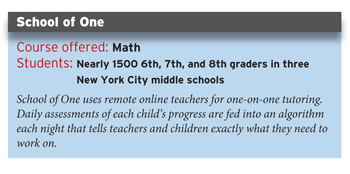 “Keeping Pace” author Watson agrees. He fears that with districts everywhere experimenting with multiple forms of virtual learning, from online credit recovery to blended learning classes, three years from now we’ll still have little to no information as to what actually works in a systemic way. And even if we know that a program is successful, we may not know why.
“Keeping Pace” author Watson agrees. He fears that with districts everywhere experimenting with multiple forms of virtual learning, from online credit recovery to blended learning classes, three years from now we’ll still have little to no information as to what actually works in a systemic way. And even if we know that a program is successful, we may not know why.
Watson cautions, however, that reliance on a few time-consuming megastudies would be a mistake. Not only are there a limited number of questions that can be answered in this manner, but perhaps more importantly, the field is moving so quickly that the practices studied may already be outdated before the results are known. Instead, he notes, it’s much more important to develop systems to track quality and collect existing information, such as course participation, grades, and assessment results, in a manner that can help monitor student outcomes and practices at the course level. And better data on the impact of curriculum, instructional materials, and teaching practices would benefit all of education, not just virtual learning. But current data, Bakia says, are extremely scarce: “in most places you can’t even tell if a course is online.”
Paul Hill adds that ongoing data collection and research is especially important for at-risk students and in areas like credit recovery, dropout prevention, and juvenile justice: “Almost every party involved with a poor kid who is about to drop out of school doesn’t want to turn that rock over.” Without outside pressure, programs for these students could be the most vulnerable to quality concerns.
Secure Independent Oversight
Once providers develop quality measures and relevant data exist, one or more independent entities must be charged with deciding which providers can enter the marketplace and holding them accountable for student outcomes. An independent entity, whether it’s an authorizer, district, or state, needs to ensure that competition rewards high quality, not just low cost or easy access.
Markets can offer new choices to parents and students. And unlike place-based charter schools, virtual learning allows these choices to be unbound by geographic constraints. A student in rural Alabama can now look online for better instructional models, make up credits for missed or failed classes, or even access Mandarin Chinese courses.
But policymakers cannot rely solely on parent and student choice to ensure quality. Sixteen-year-olds do not always make the best decisions, and parents have many different motives for choosing a virtual provider. Some may want an accelerated curriculum for a gifted student, others may be looking for more scheduling flexibility, and still others may just be interested in getting course credit quickly, regardless of quality or rigor.
The parallel to the charter experience is striking. “Parent accountability as the only driver of accountability hasn’t always worked out for charter schools, “ notes Todd Ziebarth of the NAPCS, “Parents sometimes keep sending their kids to schools that aren’t academically successful.”
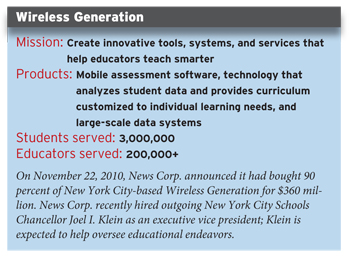 The first system of grading charter laws rewarded states for easy access to charters but put little emphasis on quality control over new and existing schools. Since then, things have changed dramatically. A report released in 2010 by the NAPCS graded states not just on the opportunities for charter schooling to expand in the state, but also on the quality of charter school authorizing supported by the state law.
The first system of grading charter laws rewarded states for easy access to charters but put little emphasis on quality control over new and existing schools. Since then, things have changed dramatically. A report released in 2010 by the NAPCS graded states not just on the opportunities for charter schooling to expand in the state, but also on the quality of charter school authorizing supported by the state law.
But current charter-school authorizing methods, which focus on an entire school, are not adequate for supplemental or blended virtual-learning providers. Nor is accreditation (until the NCAA halted the practice, fully accredited BYU Independent Study was known to college sports fans as the place where football player Michael Oher, profiled in the movie The Blind Side, and others went to quickly raise grades to become eligible for college athletics). And even in the case of virtual charter schools, authorizers are just now beginning to understand the unique qualities of virtual schools that change the nature of oversight, including these schools’ capacity to serve tens of thousands of students across wide geographic areas.
Virtual education has the potential to operate in a more nimble and responsive market than charter schools. Without the large up-front costs associated with brick-and-mortar schools and the long lag time for determining school success, the virtual education market may not need as many limits on new entrants. But for the market to yield innovation and high performance, providers need to be rewarded for successful student outcomes, not just enrollments, and an independent agency, whether it’s a charter-like authorizer, the school district, or the state, needs to be responsible for quickly shutting down low performers.
State policies, such as whether the choice to attend a virtual class (and receive access to the funding for that class) resides with the student or the district, can have a tremendous impact on access to virtual learning. It is essential that state laws be clearly thought through from the beginning, something that never happened in the pell-mell rush to enact charter school legislation. In order to get started in many states, charter supporters had to make compromises. These bad bargains underfunded schools, limited their ability to be autonomous and innovative, and allowed districts to create “charters-in-name-only.” The same pattern is emerging in virtual education, where legislation that purports to spur virtual education, such as that in Massachusetts, creates unnecessary geographic restrictions or enrollment caps, or sets funding levels well below what traditional schools receive.
The large differences in growth among state-run supplemental virtual school programs illustrate the importance of policies related to funding and access. Figure 1 shows that population does not drive the enrollment differences among state-run virtual schools. The states with the most enrollments, Florida and North Carolina, both have funding tied to the state’s public-education funding formula.
Most state-run virtual schools are not included in state funding formulas and are instead funded by an annual legislative appropriation. While start-up appropriations make sense—especially when they help to ease fears of competition for funds with traditional schools—eventually, these static funding sources, which bear no relation to the demand or quality of the virtual school offerings, artificially limit access to and therefore demand for online courses. And since access and funding are scarce, there’s little capacity or incentive to develop new offerings.
The largest of the state-run schools is Florida Virtual School (FLVS). Its funding model, in which funds follow the student, taken together with the state’s strong choice policies (a student’s full-time school may not deny access to courses offered by FLVS), enable the school to grow. There are no barriers to enrollment and funding is not capped at a preset amount, providing FLVS with an incentive to be responsive to demand, rapidly increase course offerings, and even experiment with new game-like learning experiences (see “Florida’s Online Option,” features, summer 2009). In contrast, Kentucky’s state virtual school, despite its more than 10 years in operation, struggles to grow. The school charges course fees, requires students to get district permission prior to enrollment, and is funded on a small annual appropriation rather than based on demand.
Another challenge to the development of fair and workable funding systems for virtual schooling is one that is endemic to public education in general: the inability to accurately measure cost-effectiveness. Since virtual schooling operates on a very different cost model—few facilities costs, higher technology costs, greater scale—states are struggling to determine the proper per-student funding level for both virtual courses and schools. Without a means to determine value—how additional dollars spent affect student outcomes—states default to either the standard per-pupil funding, or increasingly, decide that virtual schools should cost less and choose an arbitrary funding level. More spurious are the attempts to audit providers and pay only for the “true costs” of virtual education, eliminating any incentive for productivity gains. None of these funding methods are sensitive to the quality of student outcomes. They lead districts to favor the lowest-cost provider. And more importantly, they provide few incentives for providers to fund the research and development necessary to perfect new technologies, student support systems, and innovative methods to effectively serve more costly, at-risk student populations.
Former Florida governor Jeb Bush and former West Virginia governor Bob Wise are leading a new advocacy effort known as the Digital Learning Council. The council recently published a set of state policy recommendations as part of an initiative to spur further growth not only in virtual learning, but also in the use of digital and multimedia content.
The Digital Learning Council recommends that states eliminate restrictions on student access to virtual education, allow students to choose among multiple learning providers, call for removal of seat-time requirements, and judge schools on results rather than inputs such as class size. Taken together, the recommendations would enable all students to access virtual education and end many of the regulatory restraints that stifle the development of innovative options.
But while the recommendations accurately identify the barriers that constrain virtual education, they are light on details for ensuring that innovation actually leads to more high-quality educational options. They suggest, for example, that states evaluate “the quality of content and courses predominately based on student learning data,” yet provide few details on how to accomplish this difficult task. Likewise, recommendations for “Quality Providers” focus heavily on the removal of barriers to competition, but offer little discussion of how to enact the recommendation for “a strong system of oversight and quality control.” Too often, the recommendations assume that quality will naturally result from regulatory relief.
Overall, as guiding principles, the recommendations make sense. But, as the nation’s charter schooling experience demonstrates, policymakers must confront the difficult issue of quality at the same time as they seek new and innovative approaches to schooling.
Finally, there is nothing magical that ensures either charter schools or virtual education will be innovative and different. Each provides the opportunity for something new and potentially powerful: charters through a new governance model, virtual learning through a new instructional model.
One big difference between charter schools and virtual education is that by definition, charter schools sit outside of the traditional district system. While many of the first wave of virtual education providers—charter schools, state virtual schools, consortia of schools—incorporated both a different instructional and a different governance model, increasingly, districts are creating and managing their own virtual learning programs. The integration of virtual education into traditional school districts allows for the instructional model change to be incorporated into a system without a change in the district governance model.
The danger is that despite the dramatically different delivery model, virtual education will end up much the same—with no better outcomes than our current system. In an effort to ease concerns about online education from districts, teachers, and parents, providers will be tempted to minimize disruptions to the traditional schoolhouse model, promising that “you won’t need to change a thing.” But simply putting the same curriculum online is unlikely to result in higher-quality learning. And this approach undercuts the potential of online education to do many of the things it promises: to provide a more personalized and responsive education than the traditional lecture format, to allow students to proceed at their own pace, and to give teachers a new way to teach.
Much like the achievements of an older sibling, the charter school movement’s successes and mistakes have a lot to teach virtual schooling about bringing change to public education. Invest in good data and research, avoid bad bargains, and give students choices but don’t rely on markets alone to monitor quality are all important lessons from nearly 20 years of charter schooling. If the virtual education movement heeds these lessons, it has the potential to see even more rapid growth across the country than charter schools and—more importantly— to enhance how students learn.
Erin Dillon is a senior policy analyst and Bill Tucker is managing director at Education Sector.




